US missile defense system. 1-Part I
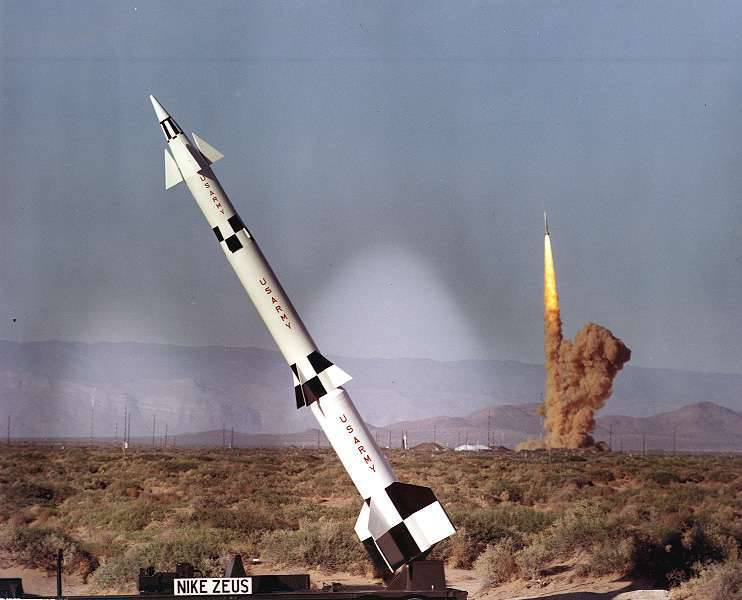
The first studies to create systems capable of counteracting ballistic missile attacks in the United States began shortly after the end of World War II. American military analysts were well aware of the danger that ballistic missiles equipped with nuclear charges could pose to the continental part of the United States. In the second half of 1945, the Air Force representatives initiated the Wizard project. The military wanted a high-speed guided missile capable of intercepting ballistic missiles superior in speed and range to German V-2. The main part of the project was conducted by scientists at the University of Michigan. Since 1947, more than 1 million has been allocated annually to theoretical studies in this area. At the same time, a radar for detecting and tracking targets was designed together with an interceptor missile.
As the topic was worked out, experts increasingly came to the conclusion that the practical implementation of the interception of ballistic missiles turned out to be much more difficult than it was at the very beginning of the work. Great difficulties arose not only with the creation of antimissiles, but also with the development of the ground component of antimissile defense - early warning radar, automated control systems and guidance. In the year of 1947, after the material was generalized and developed, the development team came to the conclusion that it would take at least 5-7 years to create the necessary computers and control systems.
Work on the program Wizard progressed very slowly. In the final design version, the interceptor was a large two-stage liquid-propellant rocket with a length of about 19 meters and a diameter of 1,8 meters. The rocket had to accelerate to a speed of about 8000 km / h and intercept the target at altitudes up to 200 kilometers, with a range of about 900 km. To compensate for errors in the guidance, the interceptor had to be equipped with a nuclear warhead, while the probability of hitting an enemy ballistic missile was estimated at 50%.
In the 1958 year, after the division of responsibilities between the Air Force, Navy and Army Command occurred in the United States, work on the creation of an interceptor missile Wizard administered by the Air Force ceased. The available groundwork for radar of an unrealized antimissile system was later used to create the AN / FPS-49 radar attack warning radar.
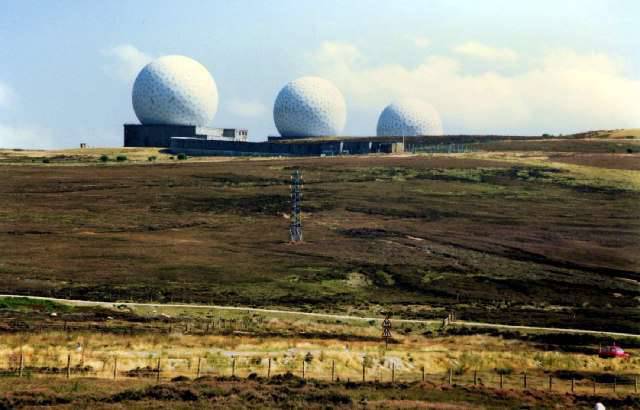
Radar AN / FPS-49, delivered at the beginning of 60-x on combat duty in Alaska, in the UK and in Greenland, was a three 25-meter parabolic antennas with a mechanical drive weight 112 tons, protected by radio-transparent fiberglass spherical domes with a diameter of 40 meters.
In 50-70, the US territory was defended from Soviet long-range bombers by anti-aircraft missile systems MIM-3 Nike Ajax and MIM-14 Nike-Hercules, which were administered by ground forces, as well as by long-range unmanned air force interceptors - CIM-XUM-YUMN-Hercules - CIM-XUM-TI unmanned airborne interceptors and CBC-XIM-10 air defense missile systems, as well as long-range unmanned air force interceptors. Most of the anti-aircraft missiles deployed in the United States, was completed with nuclear warheads. This was done in order to increase the probability of hitting group air targets in a difficult jamming environment. An 2 kt air blast of a nuclear charge could destroy everything within a radius of several hundred meters, which made it possible to effectively hit even complex, small-sized targets like supersonic cruise missiles.
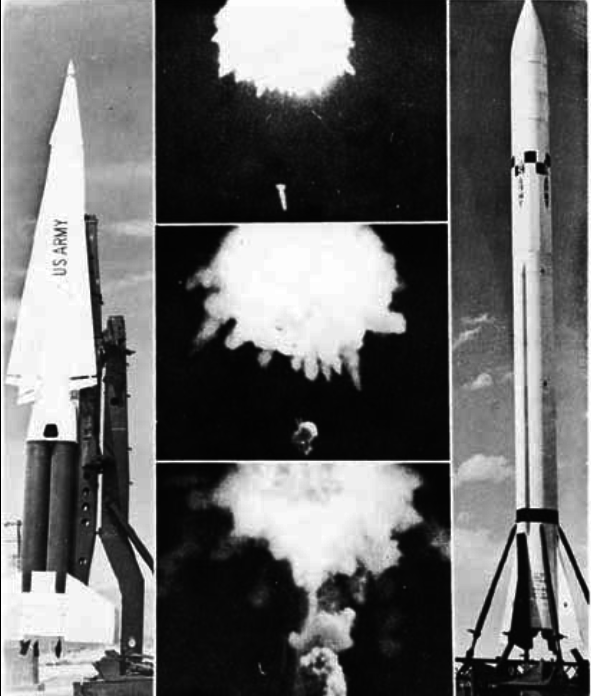
The MIM-14 Nike-Hercules anti-aircraft missiles with nuclear warheads also had some anti-missile potential, which was confirmed in practice in the 1960 year. Then, with the help of a nuclear warhead, the first successful interception of a ballistic missile, the MGM-5 Corporal, was carried out. However, the US military had no illusions about the anti-missile capabilities of the Nike-Hercules complexes. In a real combat situation, anti-aircraft complexes with missiles equipped with nuclear warheads were able to intercept no more than 10% of ICBM warheads in a very small area (for more details, see here: American anti-aircraft missile system MIM-14 "Nike-Hercules").
The three-stage rocket of the Nike-Zeus complex was an advanced Nike-Hercules SAM, which had improved overclocking characteristics due to the use of an additional stage. According to the project, it was supposed to have a ceiling up to 160 kilometers. A rocket with a length of about 14,7 meters and a diameter of about 0,91 meters in the curb state weighed 10,3 tons. The defeat of intercontinental ballistic missiles outside the atmosphere should have been carried out by a WNNXX nuclear warhead with an 50 kt power with an increased neutron yield. Weighing about 400 kg compact warhead under blasting ensured the defeat of the enemy ICBM at a distance of up to two kilometers. When irradiated with a neutron flux of an enemy warhead, the neutrons would provoke a spontaneous chain reaction inside the fissile material of the atomic charge (the so-called “pop”), which would lead to the loss of the ability to carry out a nuclear explosion or destruction.
The first modification of the Nike-Zeus-A anti-missile missile, also known as Nike-II, was launched for the first time in a two-stage configuration in August 1959. Initially, the rocket had developed aerodynamic surfaces and was designed for atmospheric interception.
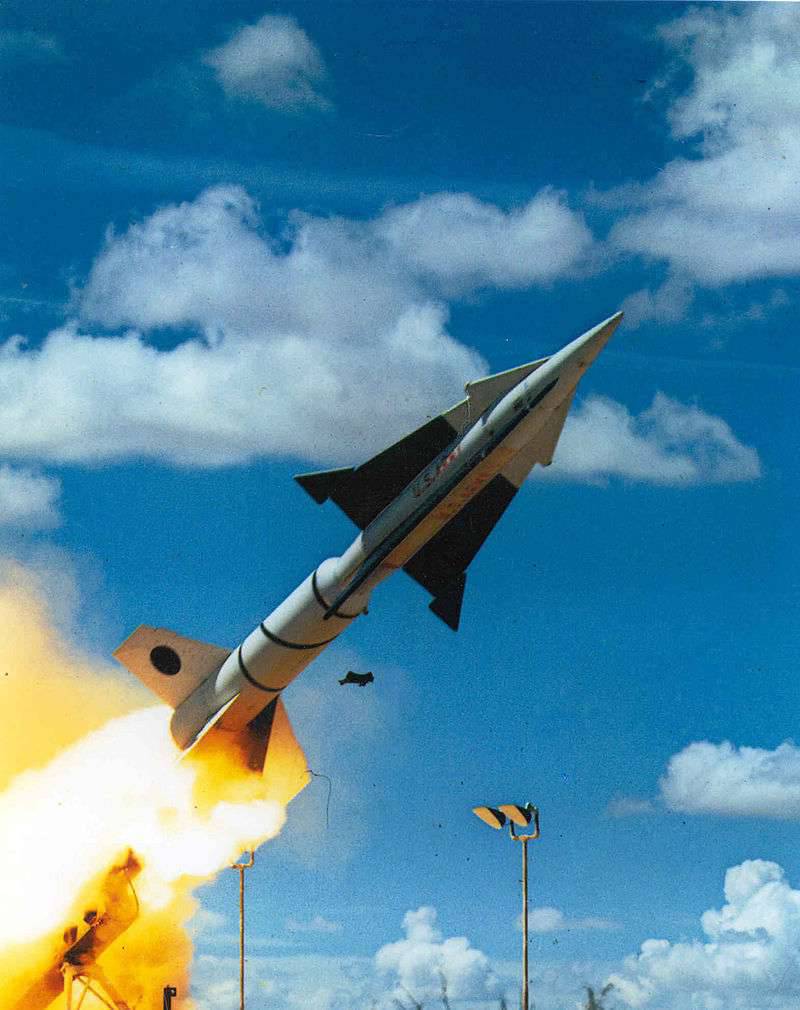
In May 1961, the first successful launch of a three-stage version of the rocket, the Nike-Zeus B, took place. Six months later, in December 1961, the first training interception took place, during which the Nike-Zeus-V rocket with an inert warhead passed at a distance of 30 meters from the Nike-Hercules SAM, which played the role of a target. In the event that the anti-missile warhead was combat, the conditional target would be guaranteed to be hit.
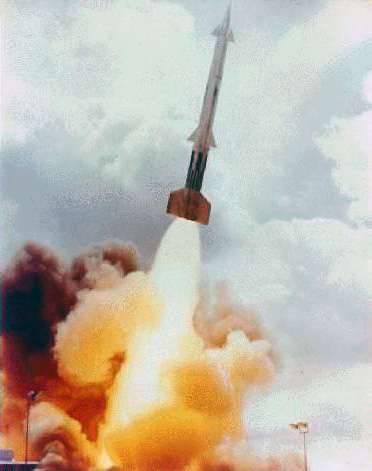
The first test launches under the Zeus program were conducted from the White Sands test site in New Mexico. However, this test site was not suitable for testing missile defense systems for a number of reasons. Intercontinental ballistic missiles launched as training targets did not have time to gain sufficient height because of closely located starting positions, because of this it was impossible to imitate the trajectory of the warhead entering the atmosphere. Another missile test site, at Point Mugu, did not meet safety requirements: when intercepting ballistic missiles launched from Canaveral, there was a threat of falling debris in densely populated areas. As a result, Kwajalein Atoll was chosen as a new missile range. The remote Pacific atoll made it possible to simulate the situation of intercepting ICBM warheads entering the atmosphere. In addition, Kwajalein already partially had the necessary infrastructure: port facilities, capital runway and radar (for more details on the US missile test sites, see here: US missile ranges).
Radar ZAR (eng. Zeus Acquisition Radar - Zeus detection radar) was created specifically for Nike-Zeus. It was intended to detect approaching warheads and issue primary target designation. The station had a very significant energy potential. The high-frequency radiation from the ZAR radar was dangerous for people more than 100 meters away from the transmitting antenna. In this regard, and in order to block the interference resulting from the reflection of the signal from ground objects, the transmitter was isolated around the perimeter by a double inclined metal fence.
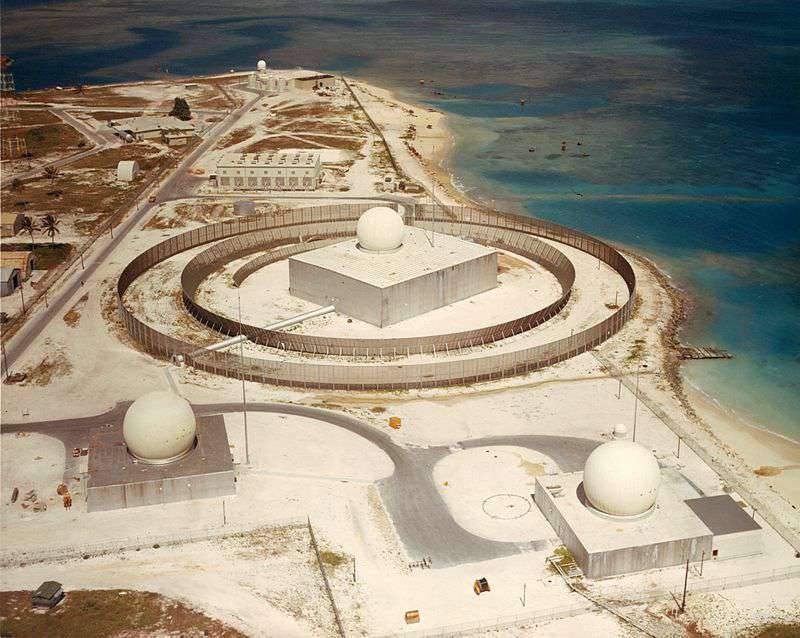
The station ZDR (eng. Zeus Discrimination Radar - radar selection "Zeus") made a selection of targets, analyzing the difference in the rate of braking accompanied warheads in the upper atmosphere. Separating real warheads from lighter false targets that were slowed down braking.
The real combat units of the ICBM that were screened out with the help of ZDR were taken to support one of the two TTR radars (Target Tracking Radar) - target tracking radar. TTR radar data on the target position was transmitted in real time to the central computing center of the anti-missile complex. After launching the anti-missile missiles at the estimated time, she was taken to escort the MTR radar (MIssile Tracking Radar), and the computer, comparing the data from the tracking stations, automatically outputting the antimissile to the calculated interception point. At the moment of the closest approach of the antimissile, a command was sent to undermine the nuclear warhead of the antimissile.
According to preliminary calculations by the designers, the ZAR radar had to calculate the target trajectory in 20 seconds and transfer it to the TTR radar for tracking. Another 25 — 30 seconds was necessary for the launched anti-missile system to destroy the warhead. The anti-missile system could simultaneously attack up to six targets, two interceptor missiles could be induced on each attacked warhead. However, when the enemy used false targets, the number of targets that could be destroyed in a minute was significantly reduced. This was due to the fact that the ZDR radar needed to “filter out” false targets.
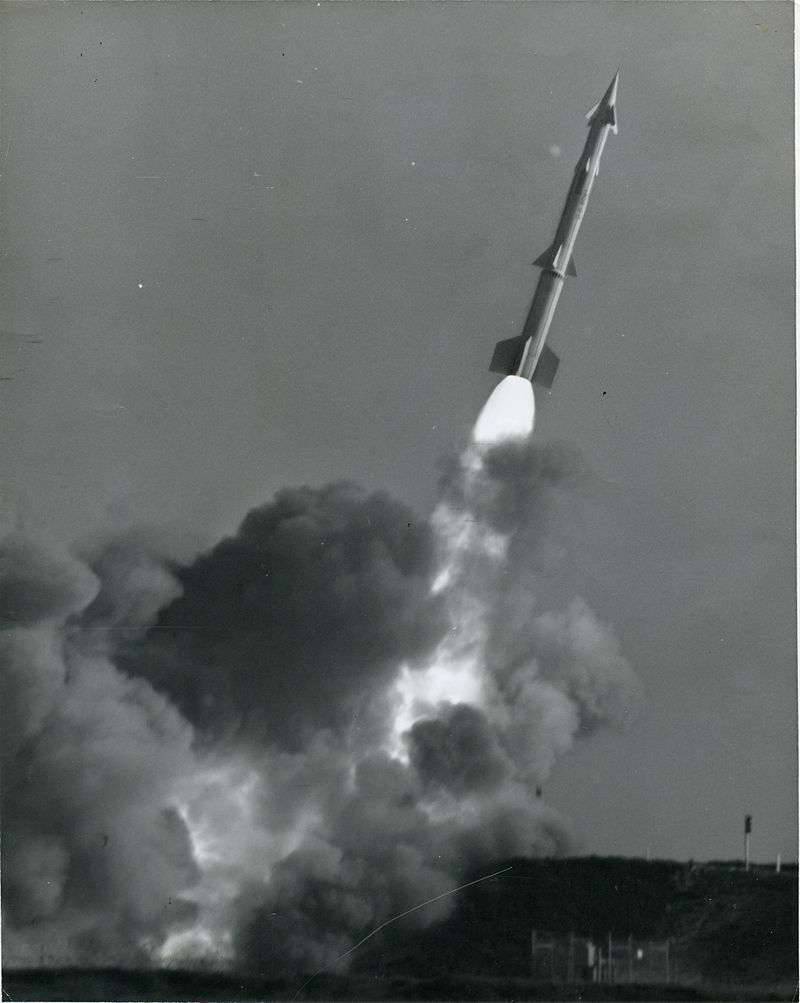
The Nike-Zeus launch complex for the project included six launch positions, consisting of two MTR radars and one TTR, as well as 16 missiles ready for launch. Information about the missile attack and the selection of false targets was transmitted to all launch positions from the ZAR and ZDR radars common to the whole complex.
The Nike-Zeus anti-missile interceptor launch complex had six TTR radars, which at the same time made it possible to intercept no more than six warheads. From the moment the target was detected and taken to escort the TTR radar, it took approximately 45 seconds to produce a firing solution, that is, the system physically could not intercept more than six attackers at the same time. Given the rapid increase in the number of Soviet ICBMs, it was predicted that the USSR would be able to break through the missile defense system by simply launching more warheads against the protected object at the same time, overwhelming the capabilities of tracking radars.
After analyzing the results of test launches of Nike-Zeus interceptors from the Kwajalein atoll, US Department of Defense specialists came to the disappointing conclusion that the anti-missile complex was not very high in combat effectiveness. In addition to frequent technical failures, the noise immunity of the detection and tracking radar left much to be desired. With the help of "Nike-Zeus" it was possible to cover a very limited area from the strikes of ICBMs, and the complex itself required very serious investments. In addition, the Americans seriously feared that the adoption of an imperfect missile defense system would lead the USSR to increase the quantitative and qualitative potential of nuclear attack weapons and to deliver a preemptive strike in the event of an aggravation of the international situation. At the beginning of 1963, despite some success, the Nike-Zeus program was finally closed. However, this did not mean abandoning the development of more effective anti-missile systems.
At the beginning of 60-x in both superpowers worked out options for using orbiting satellites as a preventive tool for a nuclear attack. A satellite with a nuclear warhead, previously bred to a low near-earth orbit, could cause a sudden nuclear strike on enemy territory.
In order to avoid the final curtailment of the program, the developers suggested using the existing Nike-Zeus anti-missiles as weapon low-orbit targets. From 1962 to 1963, a series of launches on Kwajalein was carried out as part of the development of anti-satellite weapons. In May, 1963 was successfully intercepted by a low-orbit training anti-missile target, the upper stage of the Agen launch vehicle. The Nike-Zeus anti-satellite complex was on combat duty on the Kwajalein Pacific Atoll from 1964 to 1967.
The further development of the Nike-Zeus program was the Nike-X anti-missile defense project. To implement this project, the development of new super-power radars with phased arrays, capable of simultaneously recording hundreds of targets and new computers with much higher speed and performance, was carried out. What made it possible to simultaneously direct several missiles at several targets. However, a significant obstacle to the sequential bombardment of targets was the use of nuclear warheads of antimissiles to intercept ICBM warheads. During a nuclear explosion in space, a cloud of plasma was formed that is impenetrable for radiation from radar detection and guidance. Therefore, in order to obtain the possibility of a phased destruction of the attacking warheads, it was decided to increase the range of the missiles and supplement the missile defense system being developed with another element - a compact atmospheric interceptor missile with a minimum reaction time.
A new promising missile defense system with anti-missile distant beyond the atmospheric and near atmospheric zones was launched under the designation "Sentinel" (eng. "Guard" or "Sentinel"). The far transatmospheric antimissile, created on the basis of “Nike”, received the designation LIM-49A “Spartan”, and the antimissile near interception - “Sprint”. Initially, the antimissile system was supposed to cover not only strategic facilities with nuclear weapons, but also large administrative and industrial centers. However, after analyzing the characteristics and cost of the developed elements of the missile defense system, it turned out that such expenditures on missile defense are excessive even for the American economy.
In the future, LIM-49A “Spartan” and Sprint interceptor missiles were created as part of the Safeguard anti-missile program (“Security Measure”). The Safegard system was supposed to protect the launch positions of 450 ICBM “Minuteman” from a disarming strike.
In addition to interceptor missiles, the most important elements of the American missile defense system created in 60-70-s were ground stations for early detection and tracking of targets. American specialists managed to create radars and computer complexes that were very advanced at that time. The successful implementation of the Safeguard program would have been unthinkable without a PAR or Perimeter Acquisition Radar radar. PAR radar was created based on the AN / FPQ-16 missile warning system station.
This very large locator with a peak power over 15 megawatts was the eyes of the Safeguard program. It was intended to detect warheads at distant approaches to the protected object and issue target designation. Each anti-missile system had one radar of this type. At a distance of 3200 kilometers, the PAR radar could see a radio-contrast object with a diameter of 0,25 meters. The ABM detection radar was installed on a massive reinforced concrete base, at an angle to the vertical in a given sector. The station, coupled with the computing complex, could simultaneously track and accompany dozens of targets in space. Due to the huge radius of action, it was possible to timely detect the approaching warheads and to provide a margin of time for the development of a fire solution and interception. At the moment, it is the only valid element of the “Seyfgard” system. After upgrading the radar station in North Dakota, it continued to serve as part of a missile attack warning system.
MSR or Missile Site Radar radar (eng. Radar missile position) - was designed to support the detected targets and launched on them missiles. The MSR station was located at the central position of the missile defense complex. Primary target designation МSR radar was carried out from PAR radar. After capturing on the support of the approaching military units with the help of the MSR radar, both targets and launching interceptor missiles were tracked, after which the data were transmitted to the control system computers for processing.
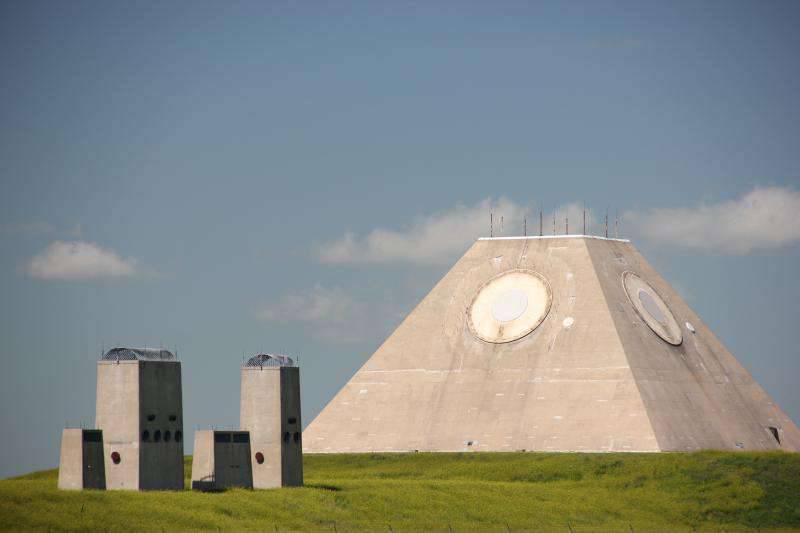
The rocket position radar was a tetrahedral truncated pyramid, on the sloping walls of which phased antenna arrays were placed. Thus, a circular review was provided and it was possible to continuously accompany the approaching targets and the intercepting missiles that took off. Directly at the base of the pyramid was placed the control center of the missile defense complex.
The LIM-49A Spartan three-stage solid propellant anti-missile (eng. Spartan) was equipped with 5 Mt with a W71 thermonuclear warhead of 1290 kg. The W71 warhead was unique in a number of technical solutions and deserves to be described in more detail. It was developed by Lawrence Laboratories specifically for the destruction of targets in space. Since no shock wave is formed in the vacuum of outer space, a powerful neutron stream should have become the main damaging factor of a thermonuclear explosion. It was assumed that under the action of powerful neutron radiation in the combat unit of the enemy ICBM, a chain reaction in the nuclear material would begin, and that would collapse without reaching the critical mass.
However, in the course of laboratory studies and nuclear tests, it turned out that for the 5 megaton warhead of the Spartan anti-missile missile, a powerful X-ray outbreak is a much more effective damaging factor. In an airless space, the X-ray flux could spread over vast distances without attenuation. When encountering an enemy warhead, powerful X-rays instantly heated up the surface of the warhead's body material to very high temperatures, which led to explosive evaporation and complete destruction of the warhead. To increase the X-ray yield, the inner shell of the W71 warhead was made of gold.
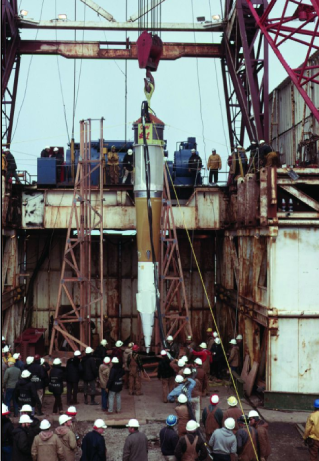
According to laboratory data, with the explosion of a thermonuclear warhead anti-missile "Spartan" target could be destroyed at a distance of 46 kilometers from the point of the explosion. The optimum, however, was considered to be the destruction of the warhead of an enemy ICBM at a distance of no more than 19 kilometers from the epicenter. In addition to the destruction of directly combat units of an ICBM, a powerful explosion guaranteed to evaporate light false warheads, thus facilitating further interceptor operations. After the Spartan anti-missiles were decommissioned, one of the “golden” warheads in the literal sense was involved in the most powerful American underground nuclear tests of the 6 of November 1971 of the year on Amchitka Island of the Aleutian Islands archipelago.
By increasing the radius of action of the Spartan missiles to 750 km and the 560 km ceiling, the problem of the masking effect was partially solved, the plasma clouds that were opaque to radar radiation from plasma clouds generated by high-altitude nuclear explosions. In terms of its layout, the largest, Spartan LIM-49A, largely repeated the Nike Zeus LIM-49 missile. With a curb weight of 13 t, it had a length of 16,8 meters with a diameter of 1,09 meter.

The two-stage solid propellant of the Sprint anti-missile was intended for intercepting ICBM warheads that broke through the Spartan anti-missile missiles after they entered the atmosphere. The advantage of interception on the atmospheric part of the trajectory was that lighter false targets, after entering the atmosphere, lagged behind the real warheads. By virtue of this, the near intra-atmospheric zone anti-missiles had no problems with filtering false targets. At the same time, the speed of the guidance systems and the acceleration characteristics of the antimissiles must be very high, since several tens of seconds passed from the moment the warhead entered the atmosphere until its explosion. In connection with this, the placement of the Sprint anti-missile missiles was assumed in the immediate vicinity of the covered objects. The defeat of the target was to occur in the explosion of a low-power W66 nuclear warhead. For reasons unknown to the author, the Sprint anti-missile was not assigned the standard three-letter designation adopted in the US military system.
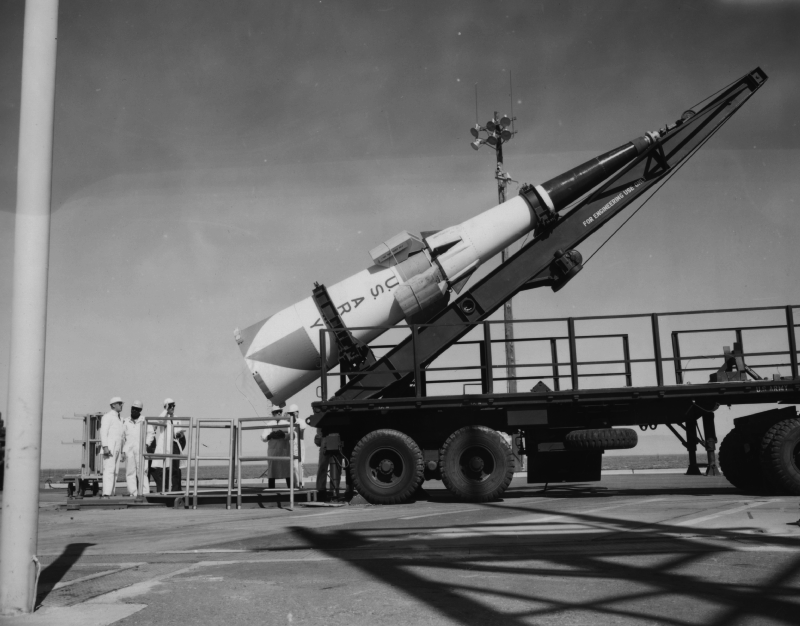
The Sprint missile was streamlined in a conical shape and, thanks to a very powerful first-stage engine, accelerated to 5 M in the first 10 seconds of flight. At the same time, the overload was about 100g. The head of the anti-missile from friction against the air one second after launch was warmed up to redness. To protect the rocket casing from overheating, it was covered with a layer of evaporating ablation material. Aiming missiles at the target was carried out using radio commands. It was quite compact, its mass did not exceed 3500 kg, and the length was 8,2 meters, with a maximum diameter of 1,35 meters. The maximum launch range was 40 kilometers, and the ceiling was 30 kilometers. The Sprint interceptor missile was launched from the silo launcher using a mortar launch.
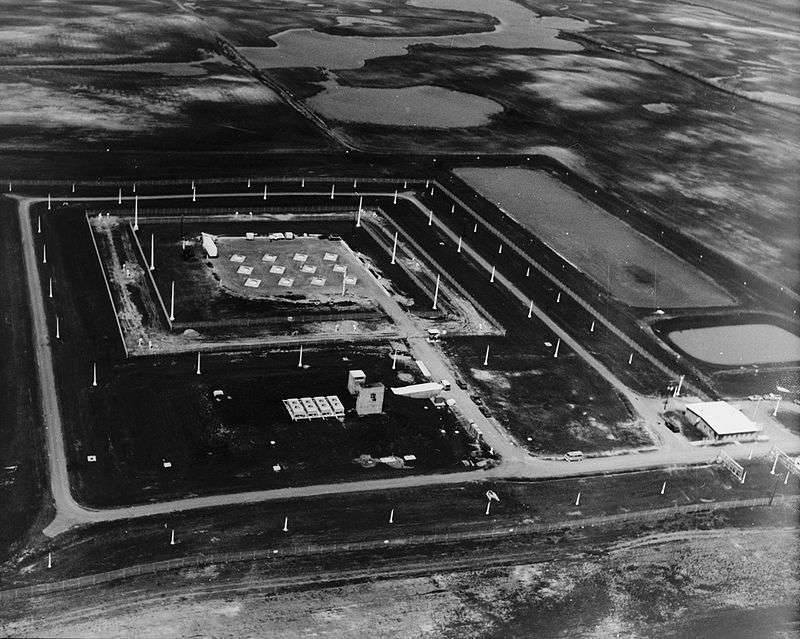
For several reasons of military-political and economic age, the LIM-49A “Spartan” and “Sprint” anti-missile missiles were short-lived in combat service. 26 May 1972 between the USSR and the USA was concluded Treaty on the limitation of missile defense systems. As part of the agreement, the parties committed themselves to refuse to build, test and deploy missile, air, space or mobile-land based missile defense systems or components to combat strategic ballistic missiles, and not to build missile defense systems in the country.
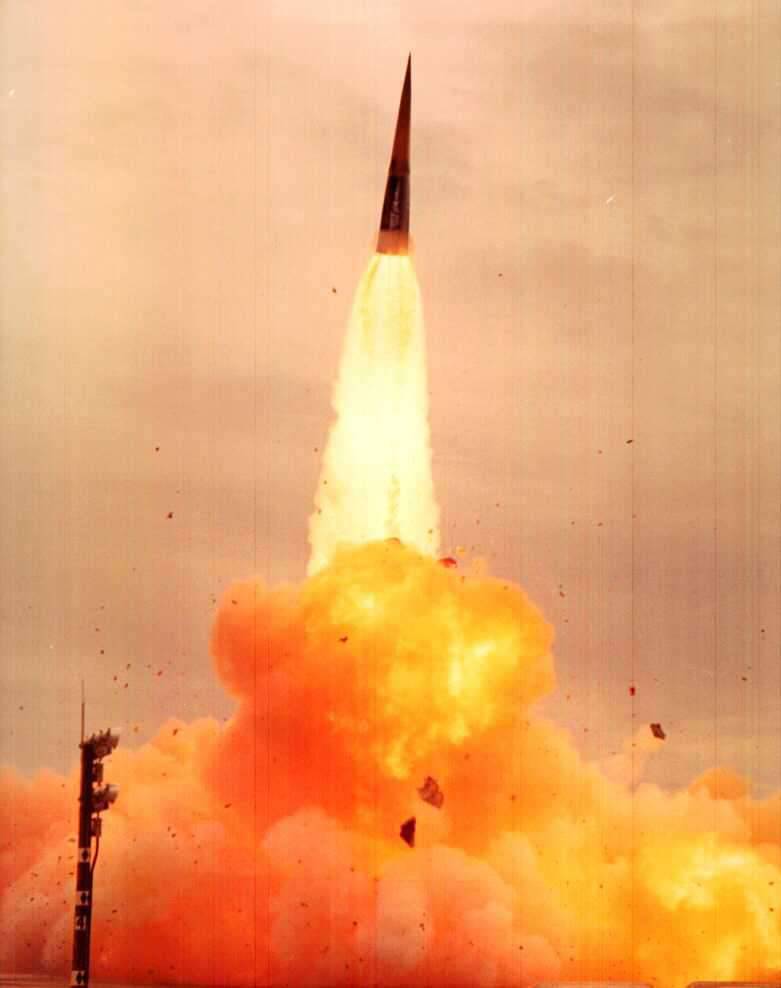
Initially, each country could have no more than two missile defense systems (around the capital and in the area where ICBM launchers are concentrated), where no more than 150 launch anti-missile launchers could be deployed within 100 radius of kilometers. In July, 1974, after additional negotiations, an agreement was concluded whereby each of the parties was allowed to have only one such system: either around the capital or in the area of ICBM launchers.
After the conclusion of the treaty, the anti-missiles Spartan, which were on combat duty for only a few months, were removed from service at the beginning of 1976. Sprint anti-missiles as part of the Safeguard missile defense system were on alert in the vicinity of the Grand Forks airbase in North Dakota, where the Minuteman ICBM launchers were located. A total of grand forks missile defense provided seventy atmospheric intercept missiles. Of these, twelve units covered the radar and missile-guiding stations. In 1976, they were also decommissioned and mothballed. In 80-ies, Sprint missile missiles without nuclear warheads were used in SDI experiments.
The main reason for the Americans' refusal of anti-missile missiles in the middle of the 70 was their dubious combat effectiveness, with very significant operating costs. In addition, the defense of the areas of deployment of ballistic missiles by that moment did not make much sense, since about half of the American nuclear potential accounted for the ballistic missiles of nuclear submarines that conducted combat patrols in the ocean.
Nuclear missile submarines dispersed under water at a considerable distance from the borders of the USSR were protected from a surprise attack better than stationary mines of ballistic missiles. The launch time for the Saifgard system coincided with the beginning of the rearmament of the American SSBNs on the UGM-73 Poseidon SLBMs with the ISGP HSR. In the future, the adoption of the Trident SLBM with intercontinental range, which could be launched from any part of the world’s ocean, was expected. Given these circumstances, the missile defense of a single deployment area of an ICBM, provided by the Safegard system, seemed too expensive.
Nevertheless, it is necessary to recognize that by the beginning of the 70's, the Americans managed to achieve significant success in creating both the missile defense system as a whole and its individual components. Solid propellant rockets with very high accelerating characteristics and acceptable performance were created in the USA. Developments in the field of creating powerful radars with long-range detection and high-performance computers became the starting point for the creation of other radar stations and automated weapons systems.
Simultaneously with the development of anti-missile systems in 50-70-e, work was underway to create new missile attack warning radars. One of the first was the over-the-horizon AN / FPS-17 radar with a detection range of 1600 km. Stations of this type were built in the first half of the 60's in Alaska, in Texas and in Turkey. If radars located in the United States were built to alert about a rocket attack, the AN / FPS-17 radar in the town of Diyarbakır in southeastern Turkey was intended to track test missile launches at the Soviet Kapustin Yar proving ground.
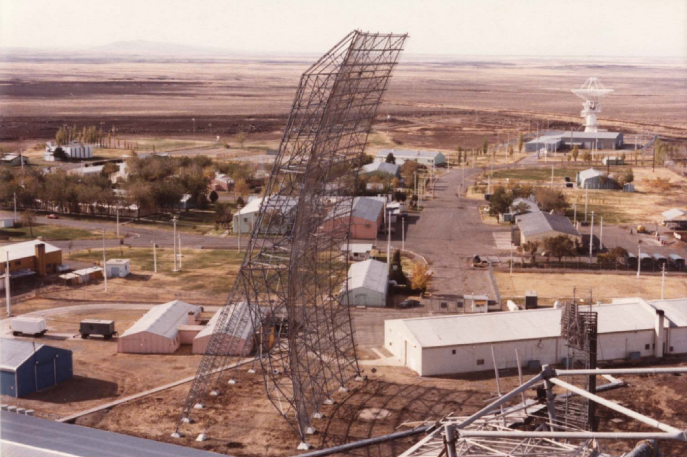
In 1962, in Alaska, near the Clear air base, a radar detection system for an early missile warning system AN / FPS-50 began to function, in 1965, an AN / FPS-92 tracking radar was added to it. The AN / FPS-50 detection radar consists of three antennas and associated equipment, which monitors three sectors. Each of the three antennas controls the sector 40 degrees and can detect objects in space at a distance of up to 5000 km. One antenna radar AN / FPS-50 occupies an area equal to the football field. The parabolic antenna of the AN / FPS-92 radar is a 26-meter plate hidden in a radio-transparent dome with a height of 43 meter.
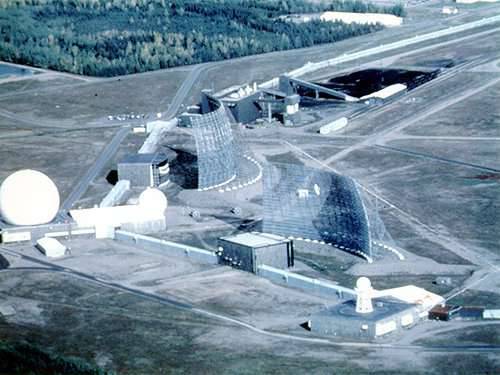
The radar complex at the Clear air base as part of the AN / FPS-50 and AN / FPS-92 radars was in operation until February 2002. After which he was replaced in Alaska radar with phased array AN / FPS-120. Despite the fact that the old radar complex has not officially been operating for 14 for years, its antennas and infrastructure have not yet been dismantled.
At the end of 60-s after the appearance of strategic submarine missile-carriers along the Atlantic and Pacific coasts of the United States, the RLS began to fix missile launches from the ocean surface. The detection system was commissioned in the 1971 year. It includes X / NUMX radar AN / FSS-8 with a detection range of more than 7 km.
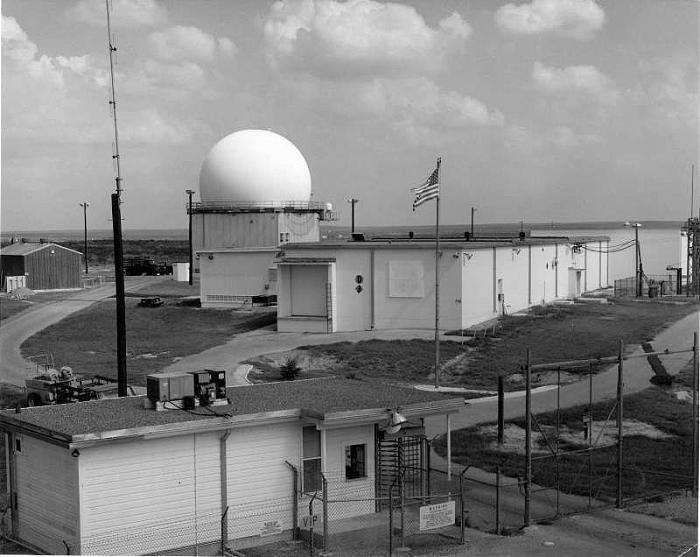
The AN / FSS-7 missile warning station was based on the AN / FPS-26 airborne surveillance radar. Despite the venerable age, several modernized radar AN / FSS-7 in the United States are still in use.
In 1971, in the UK, the AN / FPS-95 Cobra Mist trans-horizon station was built at Orforness Cape with a design detection range of up to 5000 km. Initially, the construction of the AN / FPS-95 radar was planned in Turkey. But after the Caribbean crisis, the Turks did not want to be among the priority targets for the Soviet nuclear strike. Pilot operation of the AN / FPS-95 Cobra Mist radar in the UK continued until the 1973 year. Due to unsatisfactory noise immunity, it was decommissioned, and this type of radar was later abandoned. Currently, buildings and structures of the failed American radar are used by the British BBC Broadcasting Corporation to house a radio transmission center.
More viable was the family of long-distance over-the-horizon radar with PAR, the first of which was AN / FPS-108. A station of this type was built on Shemiya Island, near Alaska.
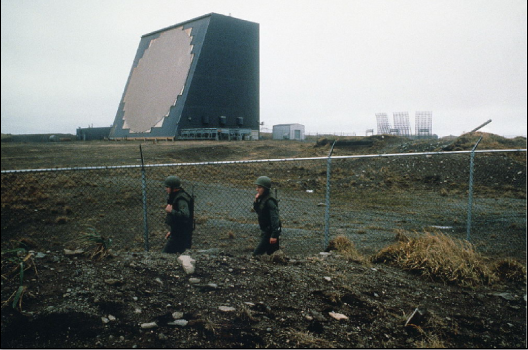
The island of Shemiya in the ridge of the Aleutian Islands was chosen as the site for the construction of an over-the-horizon radar station. From here it was very convenient to collect intelligence information about the tests of Soviet ICBMs, and to track the warheads of tested missiles falling on the target field of the Kura test site in Kamchatka. Since the commissioning of the station on the island of Shemiya repeatedly upgraded. It is currently used in the interests of the United States Missile Defense Agency.
In 1980, the first AN / FPS-115 radar was deployed. This station with an active phased antenna array is designed to detect land-based and sea-based ballistic missiles and calculate their trajectories at a distance of more than 5000 km. The station height is 32 meters. Radiating antennas are placed on two 30-meter planes with 20 degrees tilted upwards, which makes it possible to scan the beam from 3 to 85 degrees above the horizon.
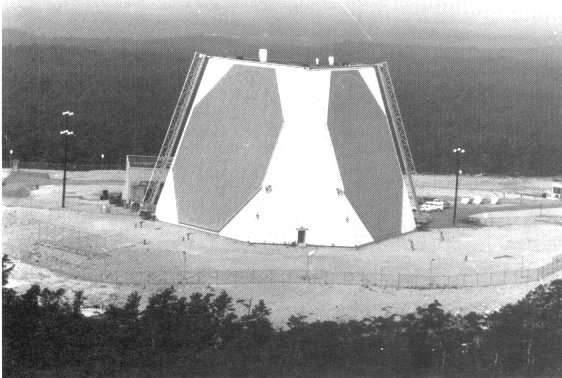
In the future, the missile warning radar AN / FPS-115 became the base on which more advanced stations were created: AN / FPS-120, AN / FPS-123, AN / FPS-126, AN / FPS-132, which are currently basis of the American missile warning system and a key element of the national missile defense system under construction.
To be continued ...
Based on:
http://www.nuclearabms.info/NikeZeus.html
https://www.youtube.com/watch?v=IcyBBSZJURk
http://www.designation-systems.net/dusrm/index.html
https://fas.org/spp/military/program/nssrm/initiatives/clearu.htm
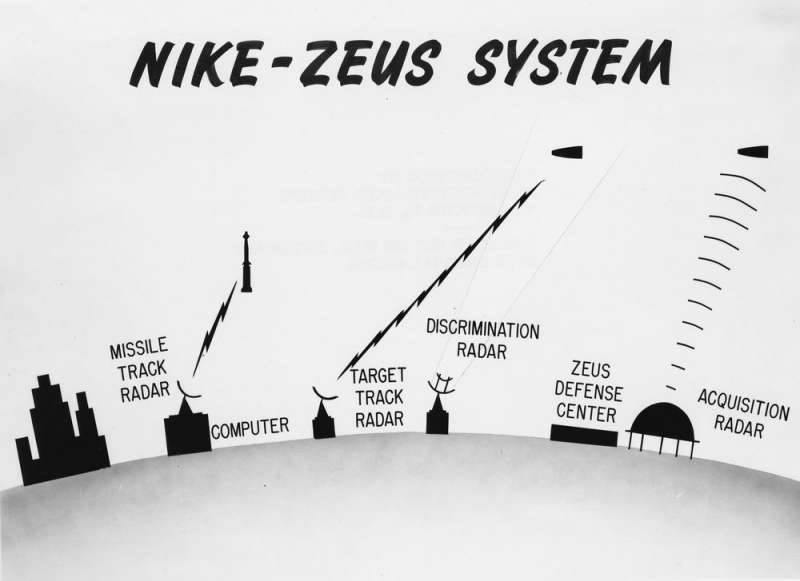
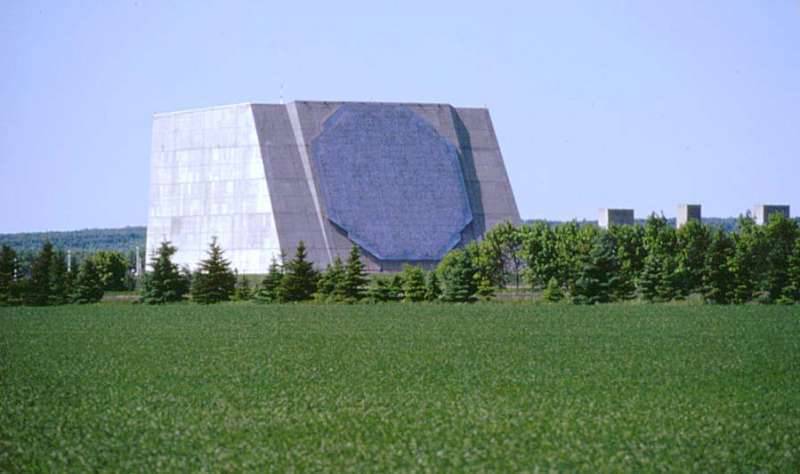
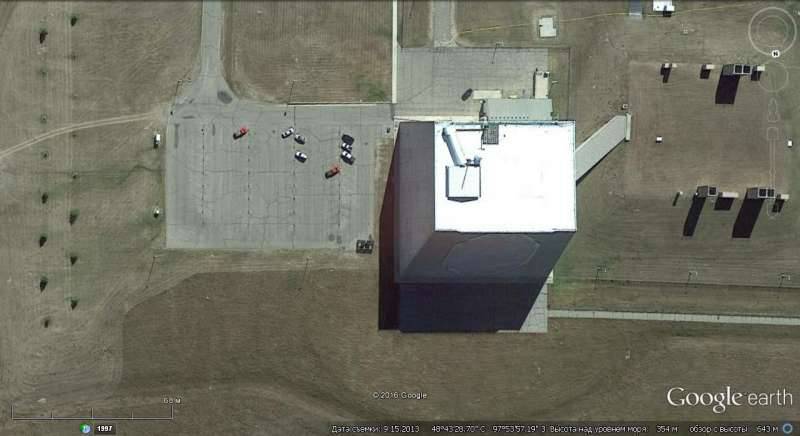
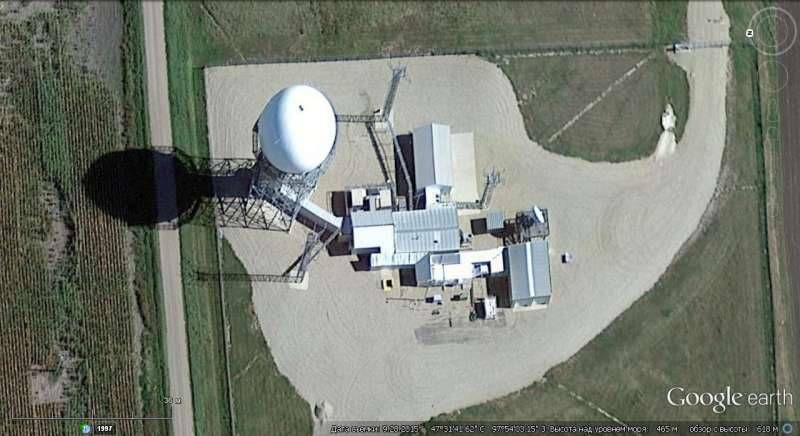
Information